about 2 months
ago -
PDX Chakerathe
-
Direct link
Namaste, As-Salamu-Alaykum, Subh bakhair and Sat Sri Akal. Today we will look at the historical and shared military branches for the British Raj. I will use India and the Raj interchangeably to denote the subcontinent, and as always everything is under development and might change. Also a special thanks to avebee and pdx_lily which has provided invaluable help during the development of the Raj.
Historical Context In 1936 the Indian subcontinent was still under British rule and had been, in some form or other, for almost 2 centuries, either during the times of the East India Company, or directly by the crown.
In World War I the Raj fought as part of the British army against the Central Powers and afterwards the independence movement was rapidly picking up steam, no longer content to be ruled from London.
Demands by leaders such as Nehru, Gandhi and Jinnah were met in part by aloofness and part in indignation, while the population at large remained impoverished. At the outbreak of World War II India was once again called to fight in a country far away from home, amassing the biggest volunteer army in history of 2.5 million soldiers.
However this was not without controversy, as local leaders weren't consulted and even imprisoned. Some went as far as siding with the Axis, notably Subhas Chandra Bose to achieve independence, down the line helping the Japanese invade Burma and India itself, before being stopped at Imphal.
As World War II came to an end the British could no longer keep control over the Raj due to mounting pressure from abroad, as well as from within. In 1947 India and Pakistan gained independence by partitioning the subcontinent, with Bangladesh gaining independence in 1971.
Princely States Princely States were historically local leaders of India that were a quasi-independent entity separated from direct British rule, but still under British control as a form of subsidiary alliance. As long as they supported the crown they could rule over their states.
In Hearts of Iron IV this is represented as high-compliance, non-core territory at the start of the game. Meaning that the Raj will now start with uncored territories, with ways to core it later.
We toyed with having the princes as puppets right from the start, but it leads to some funky interactions with subjects having subjects, and I don't think that everyone would like to be forced into having puppets as part of the main branch. However the princes can appear on the map at a later date.
The princes represented are: Mysore, Madras States, Kolhapur and Deccan States, Hyderabad, Central States, Rajputana, Western Indian States, Sindh, Balochistan, North-Western Frontier Provinces, Kashmir, Sikkim and Manipur. With Khalistan being releasable as well.
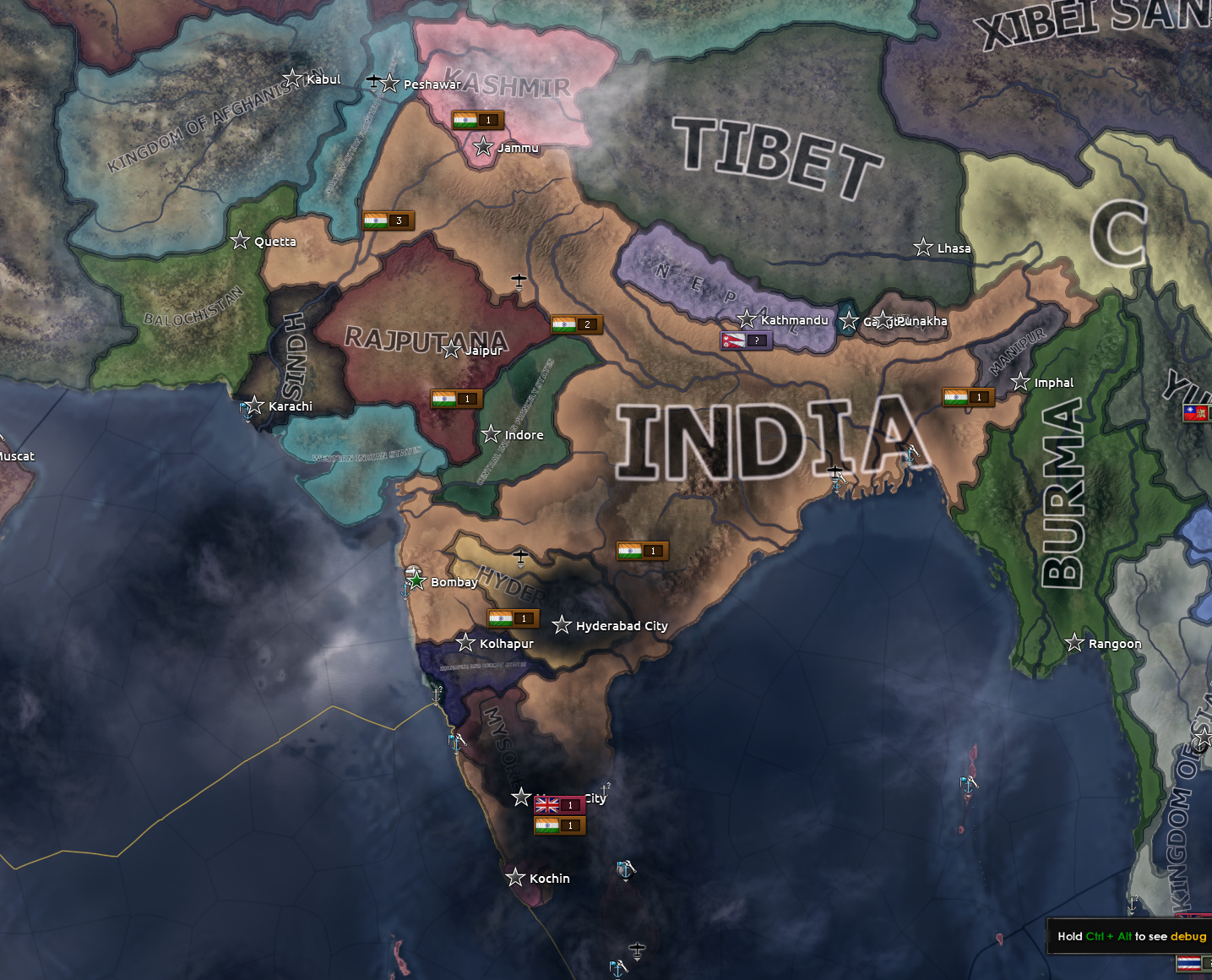
The Raj also controls a bit of Aden, as they did historically before handing it over to the British.

In the historical path you will have special ways to deal with the princes via the two special garrison laws
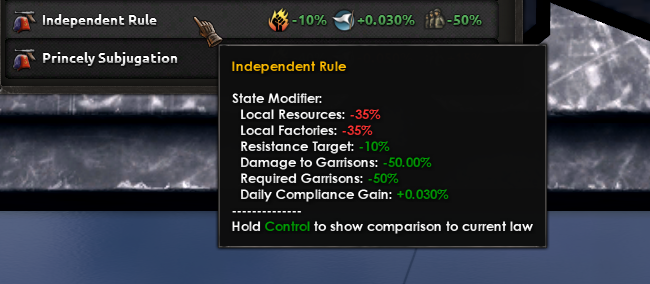
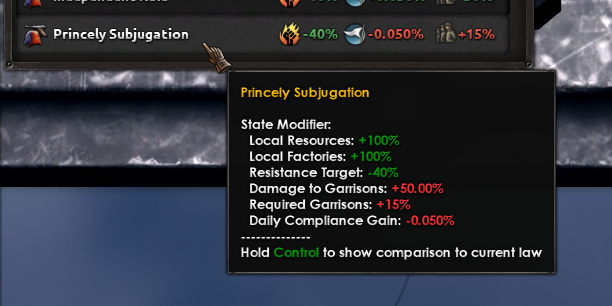
Burma Burma was officially transferred from the Raj to British control in 1937, but effectively it began with the 1935 Burma Act. In game this results in Burma being a colony of the UK instead of being occupied by the Raj.
That 1935 act notwithstanding, Burma is ethnically and culturally a bit different from the rest of India, so we believe that it makes sense to have them as a separate country. It also has mechanical implications which results in a Raj player not being able to, as easily, fortify the Siamese/Japanese front, thus having both countries having to rely more on their natural defenses instead.
Independence Branch The independence branch is also the historical branch, where you try to build an independence movement to eventually break away from the British.
While there are positive elements of British rule they serve as an antagonistic force, as being attached to their yoke depresses your growth somewhat. A key tenet of the independence branch from the start was that the player unlocks India's latent industrial capabilities as they gain more independence. So as you grow the movement you also gain more industrial capabilities.
This takes another approach compared to the old focus tree where you would use the Increase autonomy focus to break free. I went under the assumption that most players do not like being a subject in general since it reduces player agency, and that you would most of the time default to breaking free, come Hell or high water. In this new tree it becomes more about in which order you build your independence movement and what industrial capabilities you gain with less need for using continuous focuses.
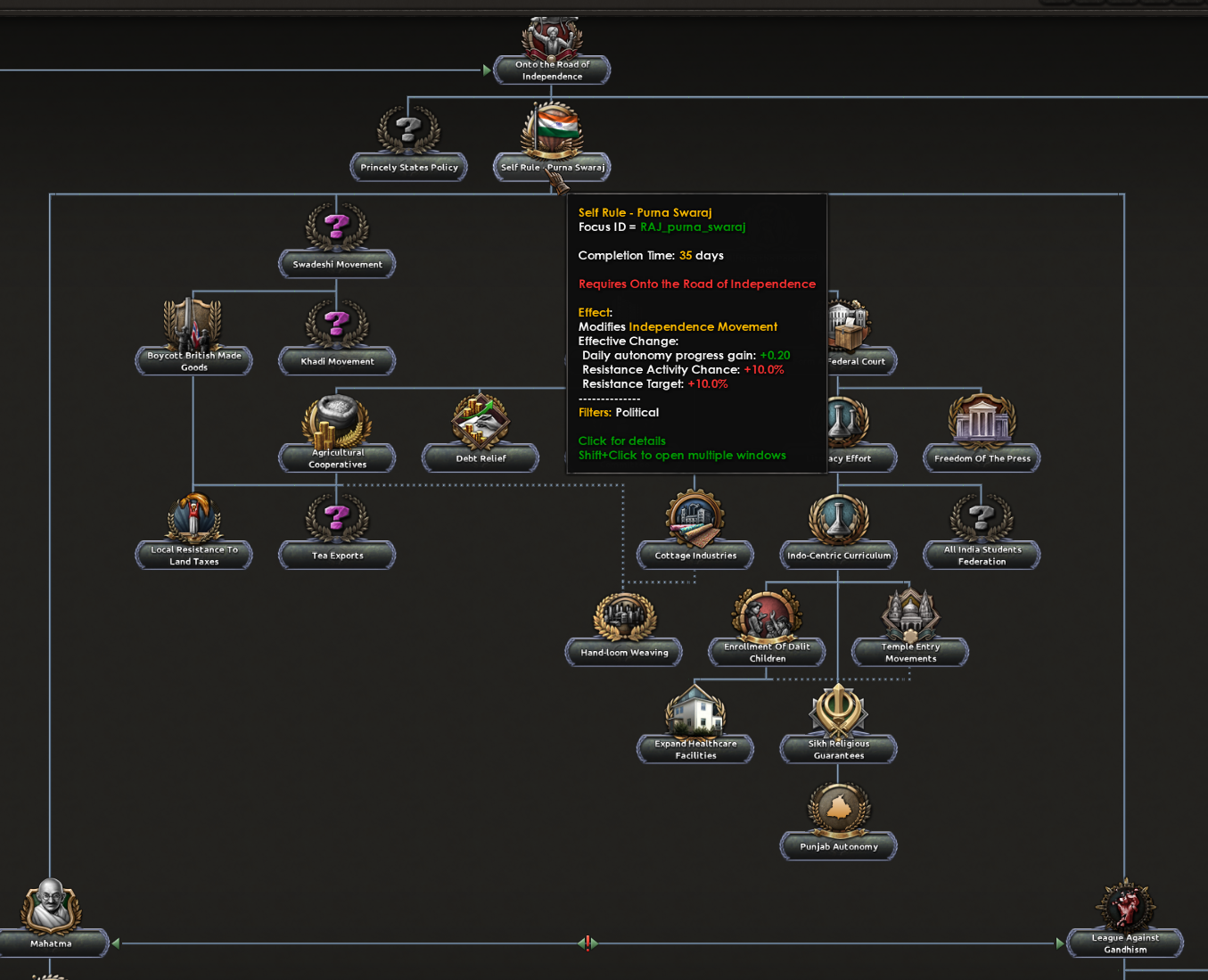
As you build up your independence movement you will also get the side effect of spillover resistance. It is not easy controlling such a large group of people with different views and interests, and violence can spill over.
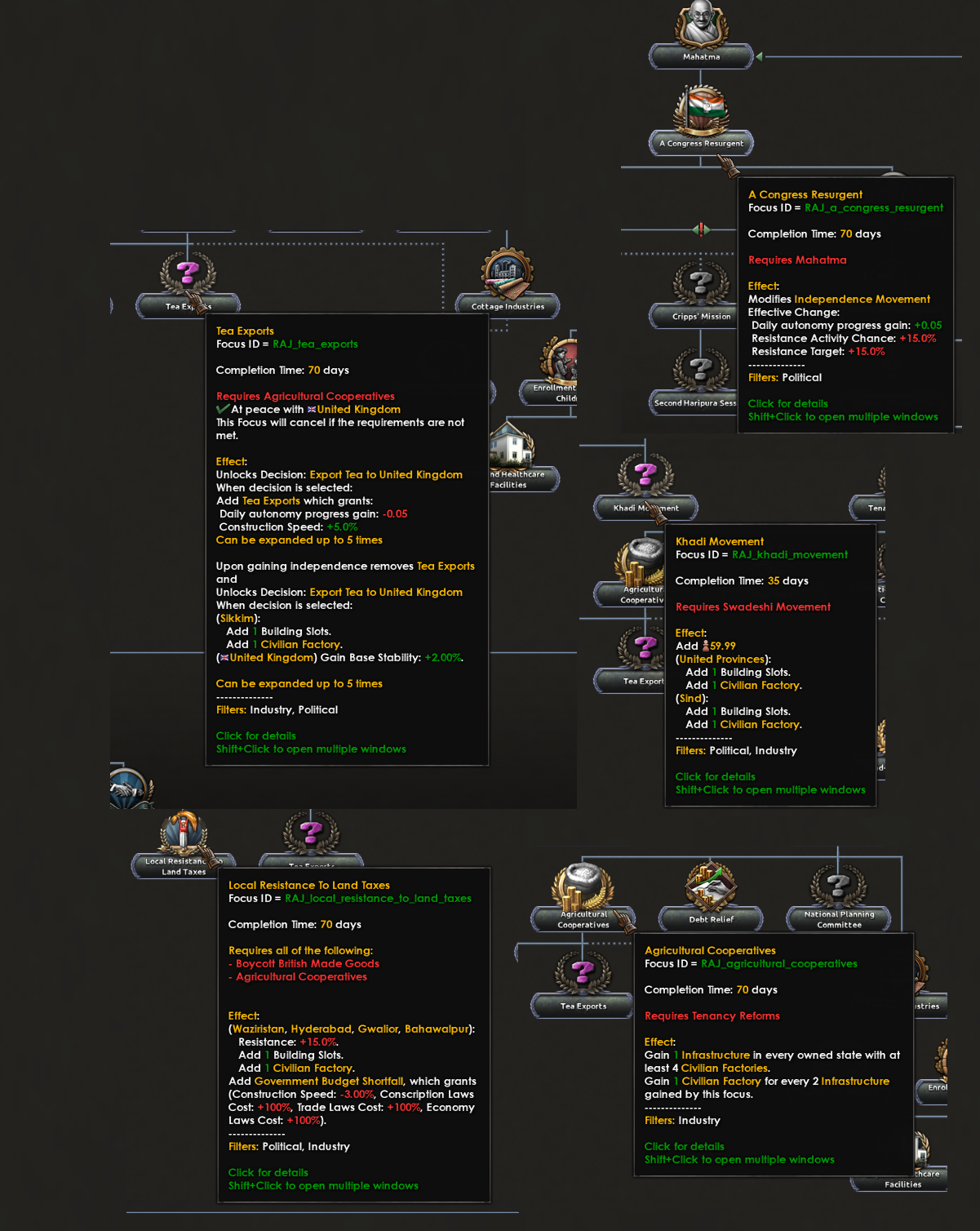
Here are some more concrete examples of how focuses can add to the players road to independence
Two Nation Theory or India United Before becoming independent you will have to choose between keeping India united, which means that you will not have to partition India into Pakistan or Bangladesh. While initially strong, keeping a united India means you will have to appease the religious minorities, leading to a moderate long term suppression of compliance, meaning it will be a bit harder to core states later on.
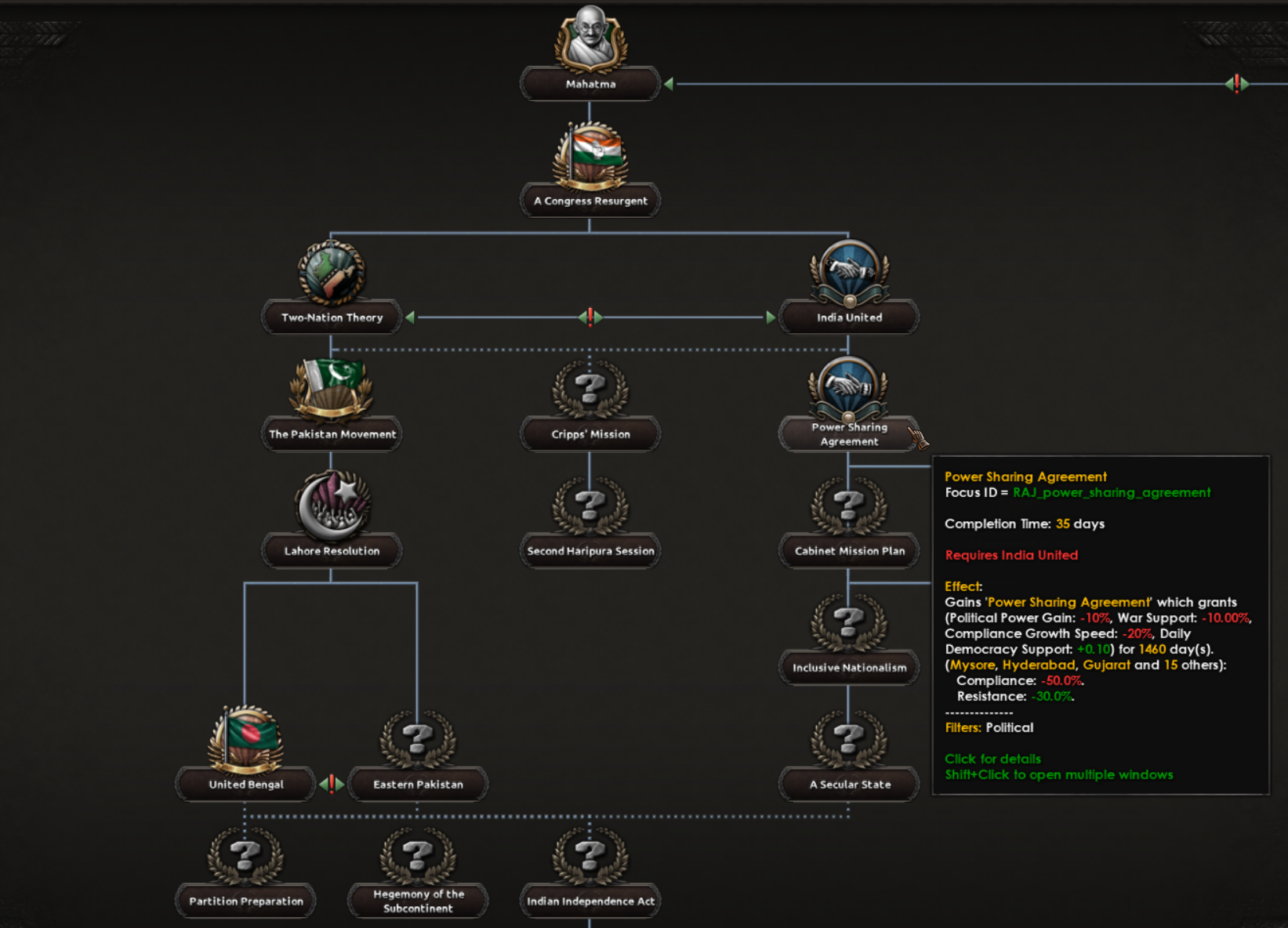
The two nation theory, which is the historical outcome, leads to the partition of the Raj into India and Pakistan. Some princely states will also rise up and become independent.

Here you can either pressure them to join you, or attack them directly if you so desire. You can pressure individual states, which means you now can get something like the Kashmir split. If there's no decisive victor between Pakistan and India in regards to pressure versus a princely state they will remain independent.
Should you decide to start hostilities with Pakistan make sure to finish quickly, or your old overlords can step in.
While you lose land in this path, you can become a Hegemon of the subcontinent, gaining you a big bonus if you gain a large advantage over your Pakistani rival, either via tech or industrial output.
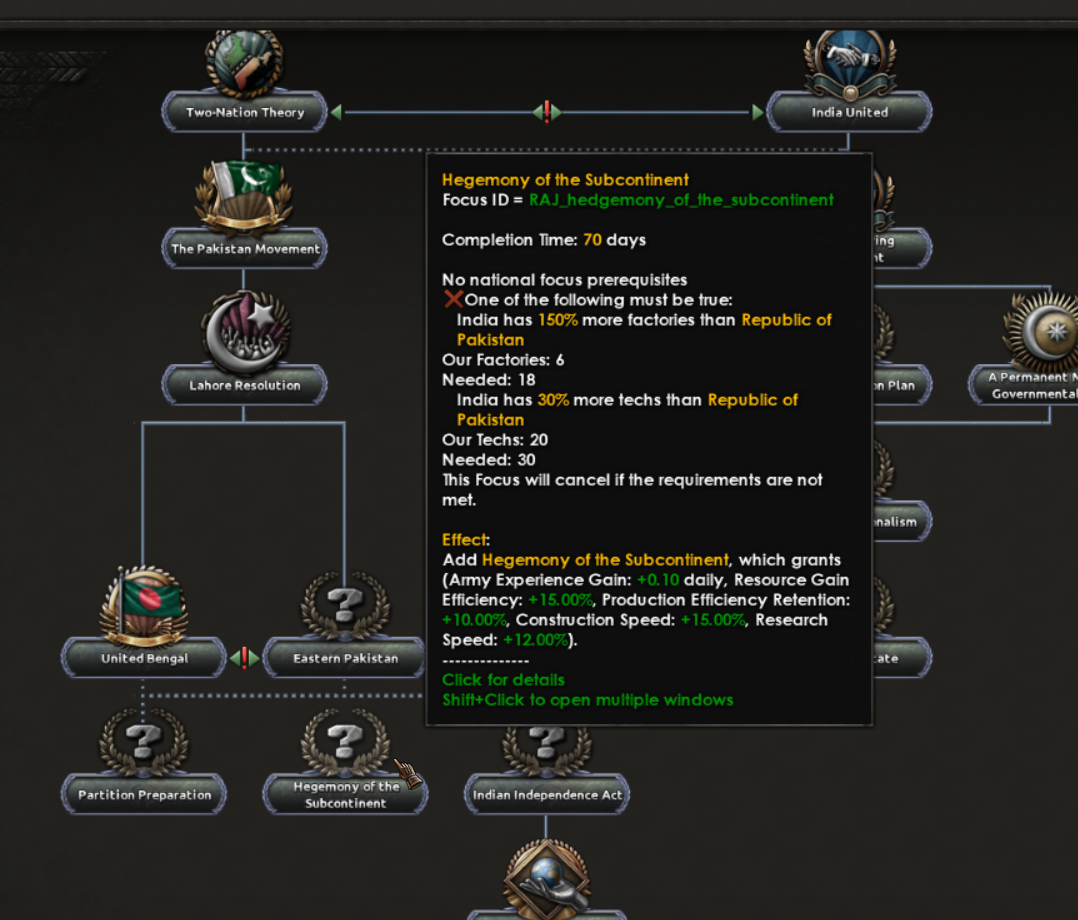
After Independence Historically, the AI will not go for independence until after '47, but the player certainly can. Doing so will unlock the last bit of industrial focus. Here you can either decide to continue as a free nation with the allies, or remain neutral, trying to act in your own self interest by sending volunteers across the world.
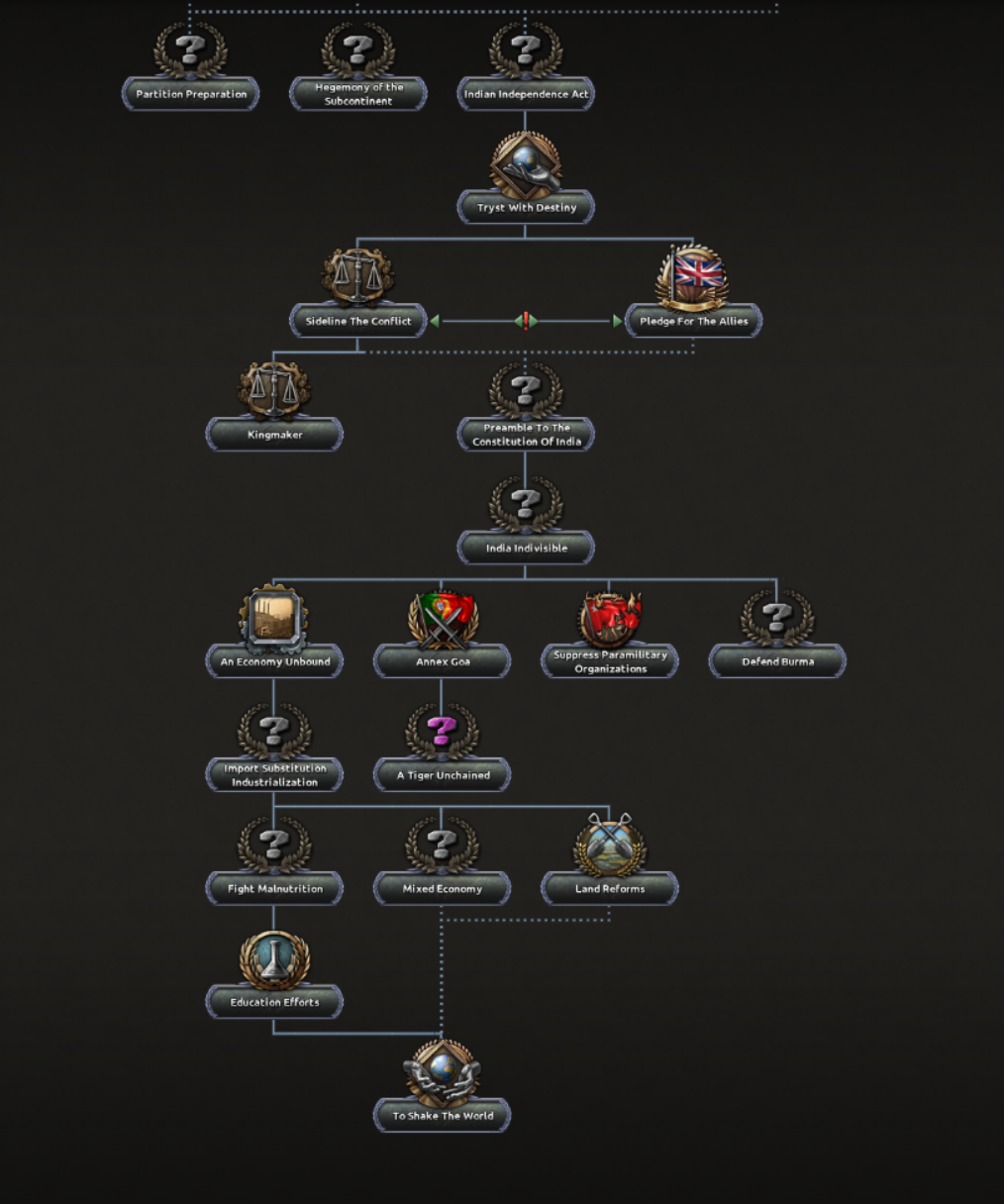
Here you will finally be able to core all territories that previously were controlled by the princes via the India Indivisible focus. This part of the focus also is meant to supercharge India's industry, moving from a suppressed nation economically to being able to play catch up with other industrialized nations.
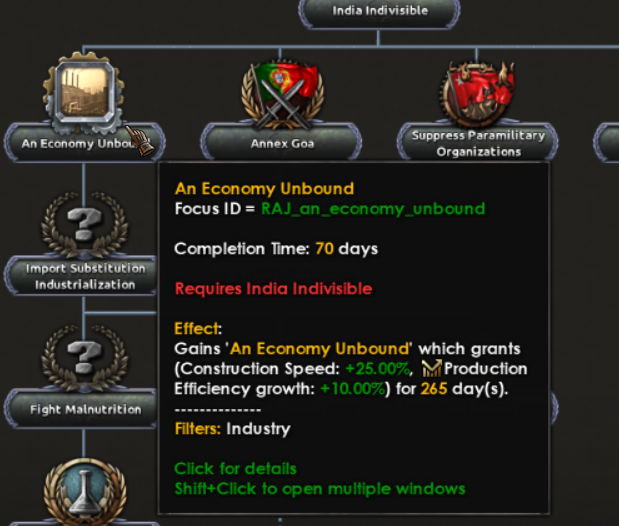
Army Shared Branches Let’s look at some of the shared army branches now. These are generally available for all paths.
Beginning here you get to choose how to model your doctrine, either leaning into the UK and their doctrine, or modelling after one of the other big majors, gaining unique themed bonuses.
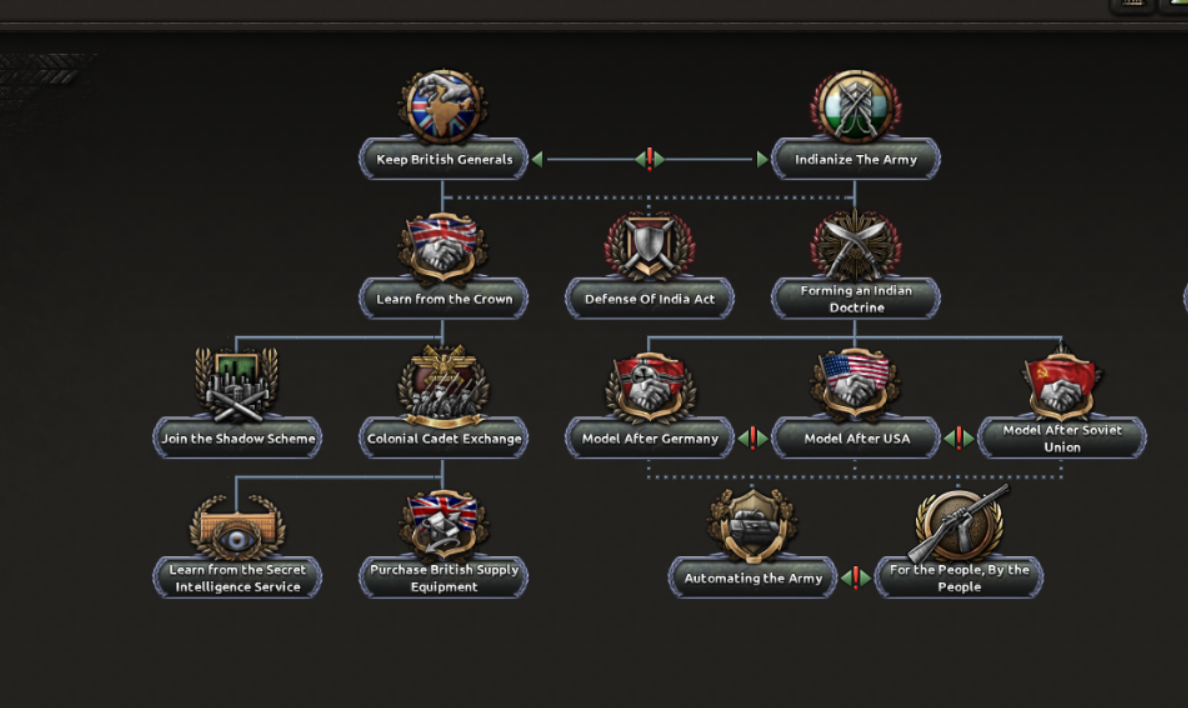
The Raj's extensive railway network also has its own sub-branch, where the more focuses you complete the faster you can build things like supply hubs, railways and infrastructure.
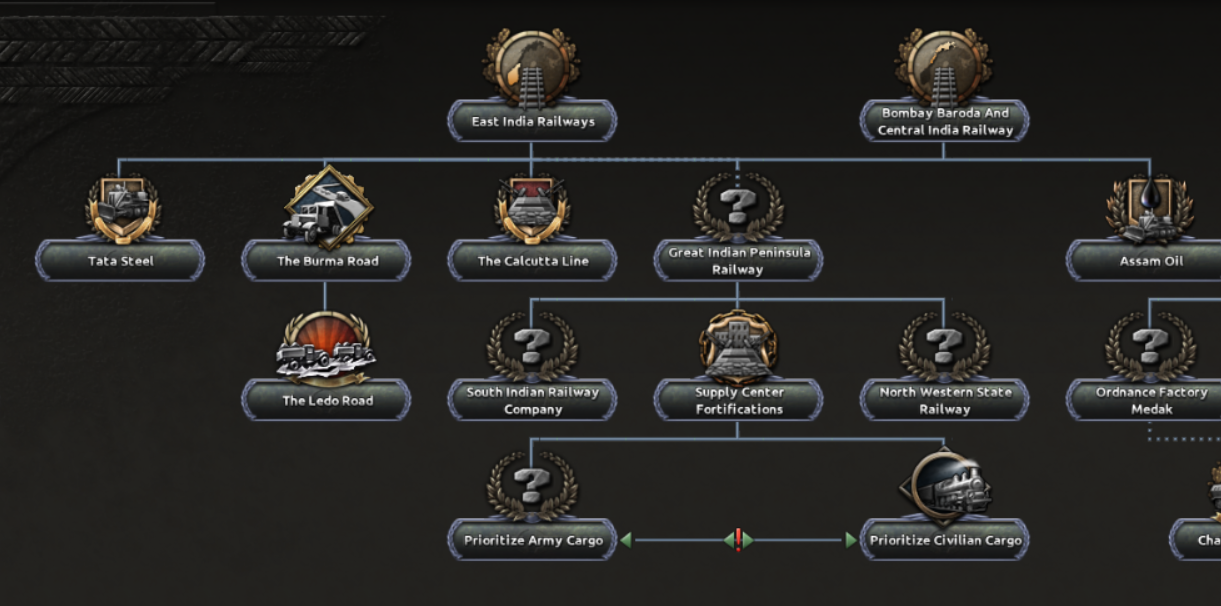
More to the right features the different Ordinance factories for the Raj, which not only adds extra factories, but each Ordinance factory unlocks extra traits for the MIO as well. When you get to the end of the path you'll get an upgraded MIO policy as a reward.

Additionally there is an assortment of military focuses that deal with improving the general technology of the Raj. Particularly the Raj will have focuses that make their forces more adept in mountainous terrain, both for tanks, artillery and infantry.
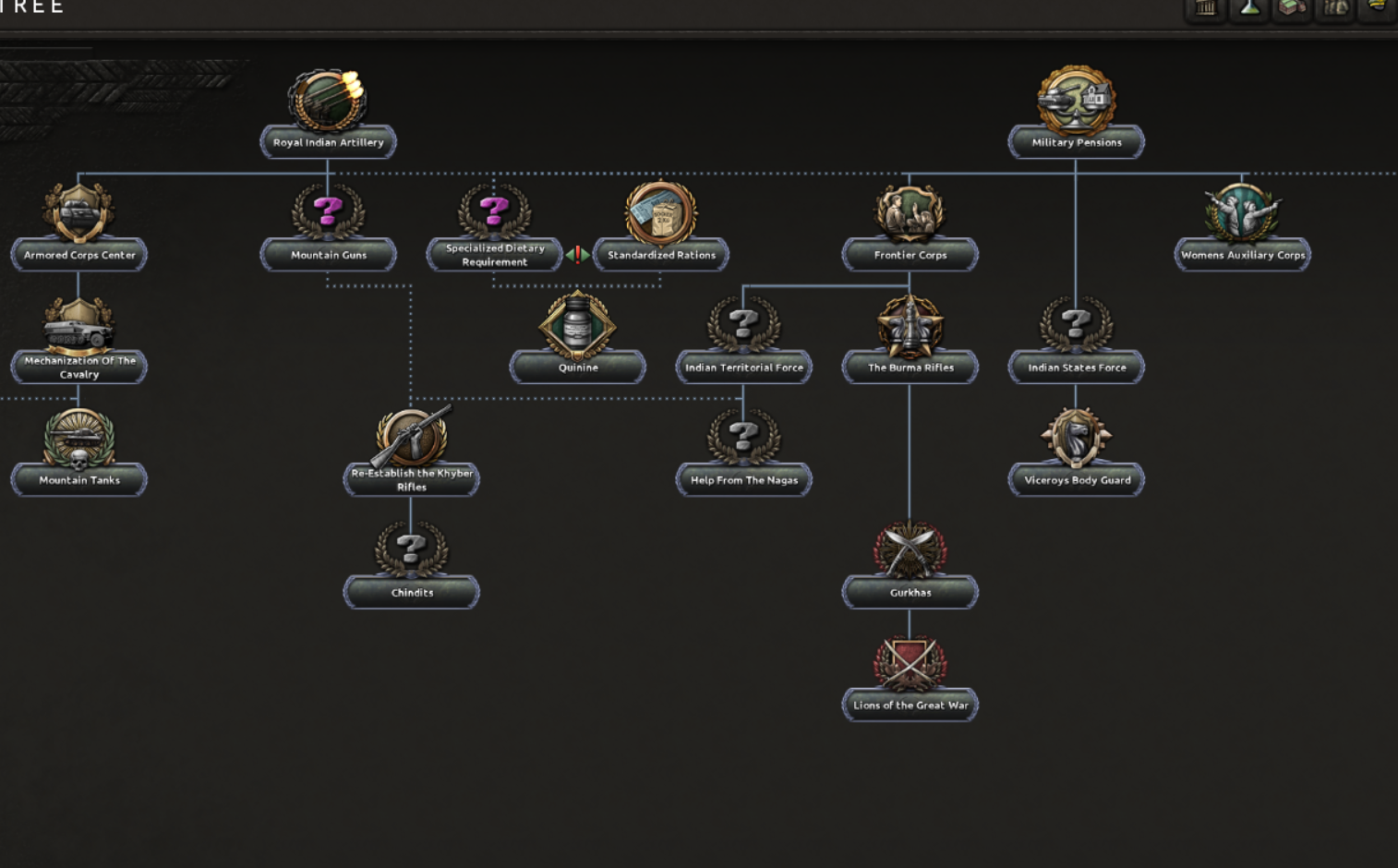
Agrarian society is still here, same as before with some additional maluses. There are a few ways to deal with it now
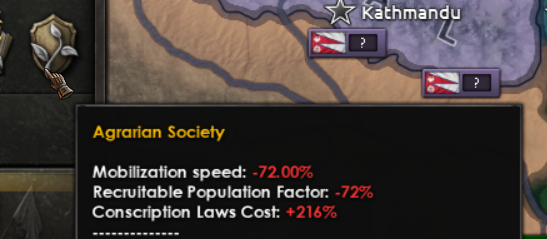
When you first complete Local recruitment offices the malus will start to gradually ebb away. This can be shortened eventually by completing additional focuses.
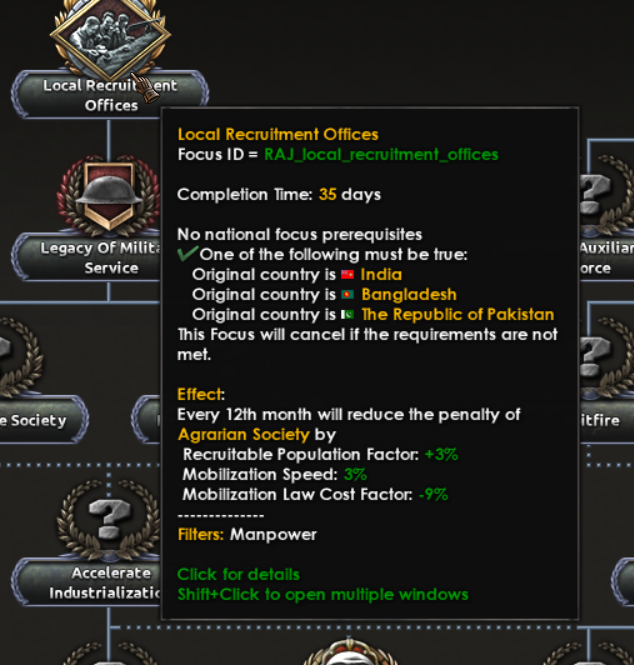
If you are in a hurry though you can complete additional focuses to instantly reduce the negative effects
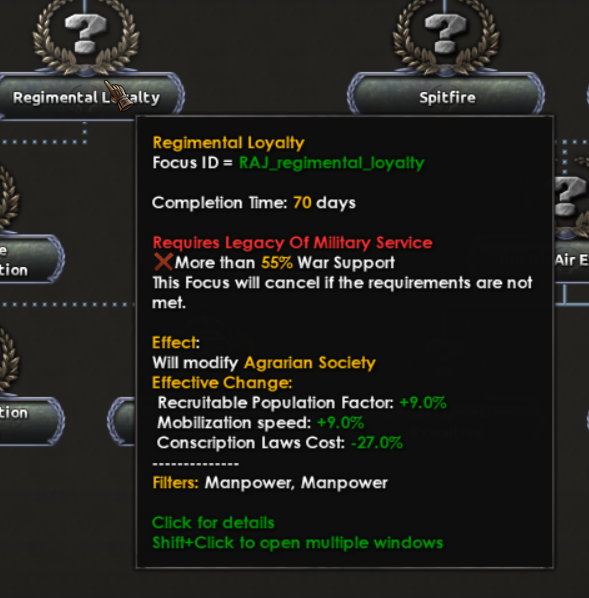
In the end you can unlock a decision to fully remove the Agrarian Society against a large cost of political power.

The Bengal Famine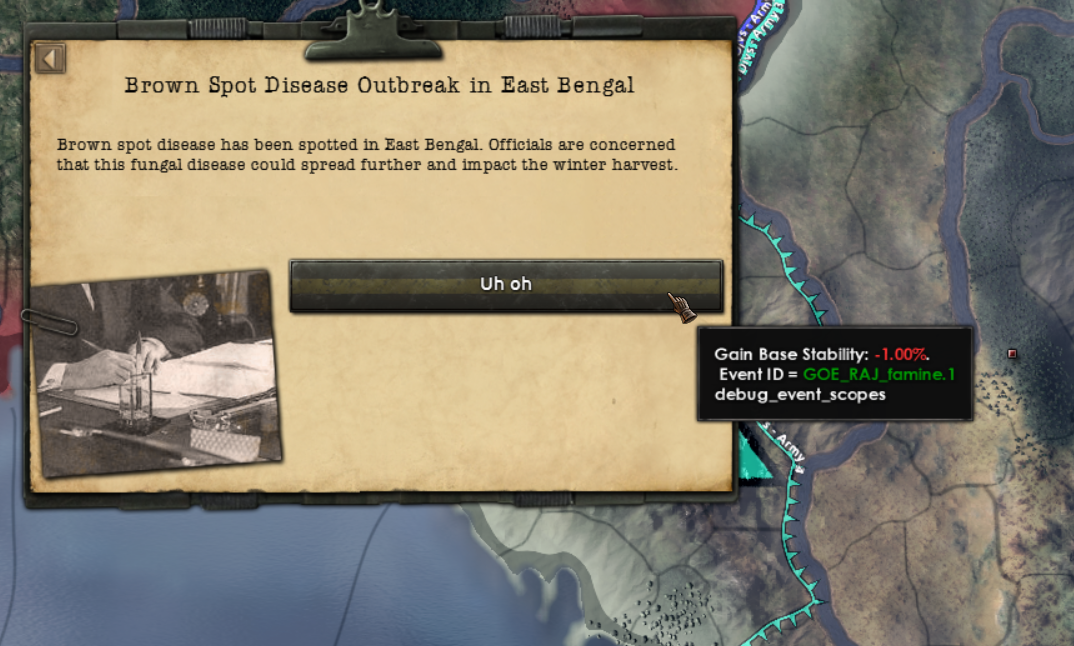
The Bengal Famine was a devastating event where food became unavailable for a large majority of people due to several external shocks to a fragile food system. This now happens under certain conditions. When Burma loses a state and is in a faction with the Raj, when the Raj loses a state that it controls at game start, or after a certain date in history.
It will start in a certain state, after a series of escalating events. They are now both a state modifier and a country modifier. The country modifier scales how bad it is depending on how many state modifiers there are. For example in this scenario the famine started in Bengal and has spread out of control to three adjacent states.
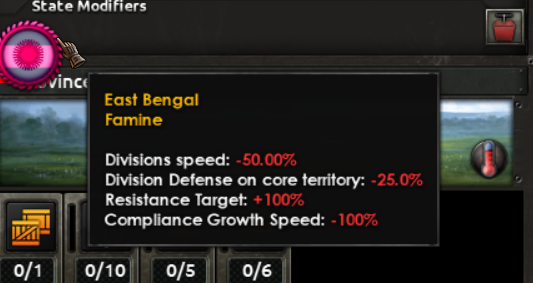
In addition to causing havoc in the state it also causes chaos on a country level
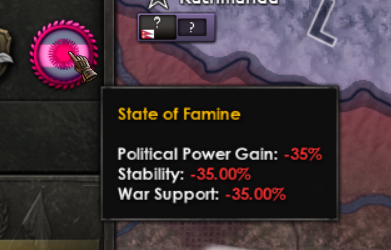
As a result I have deployed several emergency measures to try and prevent the spread, such as asking for international aid, shutting down black markets and deploying emergency healthcare.
I should have also prepared better. Some focuses in the trees will also reduce the risk of the famine spreading.
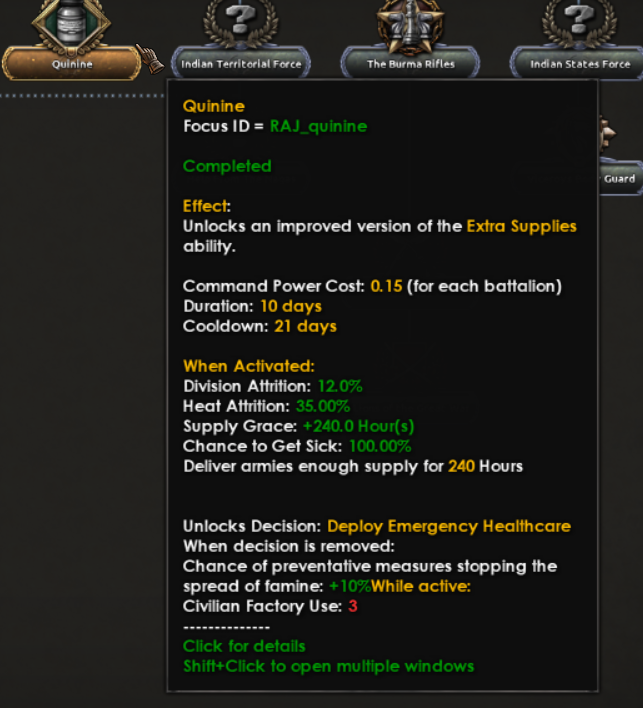
The preventative measures act as a "shield", both preventing the spread of famine and also reducing the time it takes for the famine to abate.
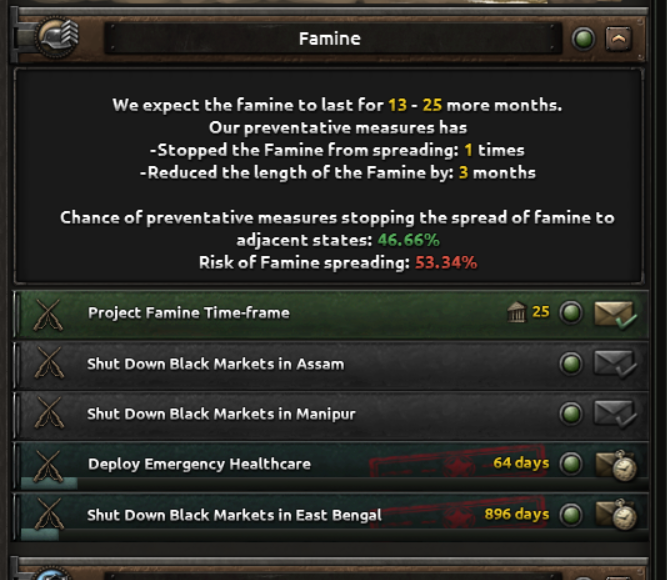
I will leave it here, but if you have any questions about a specific focus or feature, feel free to ask!
If you haven't already, check out the Expansion pass by clicking here, or the picture above!
Historical Context In 1936 the Indian subcontinent was still under British rule and had been, in some form or other, for almost 2 centuries, either during the times of the East India Company, or directly by the crown.
In World War I the Raj fought as part of the British army against the Central Powers and afterwards the independence movement was rapidly picking up steam, no longer content to be ruled from London.
Demands by leaders such as Nehru, Gandhi and Jinnah were met in part by aloofness and part in indignation, while the population at large remained impoverished. At the outbreak of World War II India was once again called to fight in a country far away from home, amassing the biggest volunteer army in history of 2.5 million soldiers.
However this was not without controversy, as local leaders weren't consulted and even imprisoned. Some went as far as siding with the Axis, notably Subhas Chandra Bose to achieve independence, down the line helping the Japanese invade Burma and India itself, before being stopped at Imphal.
As World War II came to an end the British could no longer keep control over the Raj due to mounting pressure from abroad, as well as from within. In 1947 India and Pakistan gained independence by partitioning the subcontinent, with Bangladesh gaining independence in 1971.
Princely States Princely States were historically local leaders of India that were a quasi-independent entity separated from direct British rule, but still under British control as a form of subsidiary alliance. As long as they supported the crown they could rule over their states.
In Hearts of Iron IV this is represented as high-compliance, non-core territory at the start of the game. Meaning that the Raj will now start with uncored territories, with ways to core it later.
We toyed with having the princes as puppets right from the start, but it leads to some funky interactions with subjects having subjects, and I don't think that everyone would like to be forced into having puppets as part of the main branch. However the princes can appear on the map at a later date.
The princes represented are: Mysore, Madras States, Kolhapur and Deccan States, Hyderabad, Central States, Rajputana, Western Indian States, Sindh, Balochistan, North-Western Frontier Provinces, Kashmir, Sikkim and Manipur. With Khalistan being releasable as well.

The Raj also controls a bit of Aden, as they did historically before handing it over to the British.

In the historical path you will have special ways to deal with the princes via the two special garrison laws


Burma Burma was officially transferred from the Raj to British control in 1937, but effectively it began with the 1935 Burma Act. In game this results in Burma being a colony of the UK instead of being occupied by the Raj.
That 1935 act notwithstanding, Burma is ethnically and culturally a bit different from the rest of India, so we believe that it makes sense to have them as a separate country. It also has mechanical implications which results in a Raj player not being able to, as easily, fortify the Siamese/Japanese front, thus having both countries having to rely more on their natural defenses instead.
Independence Branch The independence branch is also the historical branch, where you try to build an independence movement to eventually break away from the British.
While there are positive elements of British rule they serve as an antagonistic force, as being attached to their yoke depresses your growth somewhat. A key tenet of the independence branch from the start was that the player unlocks India's latent industrial capabilities as they gain more independence. So as you grow the movement you also gain more industrial capabilities.
This takes another approach compared to the old focus tree where you would use the Increase autonomy focus to break free. I went under the assumption that most players do not like being a subject in general since it reduces player agency, and that you would most of the time default to breaking free, come Hell or high water. In this new tree it becomes more about in which order you build your independence movement and what industrial capabilities you gain with less need for using continuous focuses.

As you build up your independence movement you will also get the side effect of spillover resistance. It is not easy controlling such a large group of people with different views and interests, and violence can spill over.

Here are some more concrete examples of how focuses can add to the players road to independence
Two Nation Theory or India United Before becoming independent you will have to choose between keeping India united, which means that you will not have to partition India into Pakistan or Bangladesh. While initially strong, keeping a united India means you will have to appease the religious minorities, leading to a moderate long term suppression of compliance, meaning it will be a bit harder to core states later on.

The two nation theory, which is the historical outcome, leads to the partition of the Raj into India and Pakistan. Some princely states will also rise up and become independent.

Here you can either pressure them to join you, or attack them directly if you so desire. You can pressure individual states, which means you now can get something like the Kashmir split. If there's no decisive victor between Pakistan and India in regards to pressure versus a princely state they will remain independent.
Should you decide to start hostilities with Pakistan make sure to finish quickly, or your old overlords can step in.
While you lose land in this path, you can become a Hegemon of the subcontinent, gaining you a big bonus if you gain a large advantage over your Pakistani rival, either via tech or industrial output.

After Independence Historically, the AI will not go for independence until after '47, but the player certainly can. Doing so will unlock the last bit of industrial focus. Here you can either decide to continue as a free nation with the allies, or remain neutral, trying to act in your own self interest by sending volunteers across the world.

Here you will finally be able to core all territories that previously were controlled by the princes via the India Indivisible focus. This part of the focus also is meant to supercharge India's industry, moving from a suppressed nation economically to being able to play catch up with other industrialized nations.

Army Shared Branches Let’s look at some of the shared army branches now. These are generally available for all paths.
Beginning here you get to choose how to model your doctrine, either leaning into the UK and their doctrine, or modelling after one of the other big majors, gaining unique themed bonuses.

The Raj's extensive railway network also has its own sub-branch, where the more focuses you complete the faster you can build things like supply hubs, railways and infrastructure.

More to the right features the different Ordinance factories for the Raj, which not only adds extra factories, but each Ordinance factory unlocks extra traits for the MIO as well. When you get to the end of the path you'll get an upgraded MIO policy as a reward.

Additionally there is an assortment of military focuses that deal with improving the general technology of the Raj. Particularly the Raj will have focuses that make their forces more adept in mountainous terrain, both for tanks, artillery and infantry.

Agrarian society is still here, same as before with some additional maluses. There are a few ways to deal with it now

When you first complete Local recruitment offices the malus will start to gradually ebb away. This can be shortened eventually by completing additional focuses.

If you are in a hurry though you can complete additional focuses to instantly reduce the negative effects

In the end you can unlock a decision to fully remove the Agrarian Society against a large cost of political power.

The Bengal Famine

The Bengal Famine was a devastating event where food became unavailable for a large majority of people due to several external shocks to a fragile food system. This now happens under certain conditions. When Burma loses a state and is in a faction with the Raj, when the Raj loses a state that it controls at game start, or after a certain date in history.
It will start in a certain state, after a series of escalating events. They are now both a state modifier and a country modifier. The country modifier scales how bad it is depending on how many state modifiers there are. For example in this scenario the famine started in Bengal and has spread out of control to three adjacent states.

In addition to causing havoc in the state it also causes chaos on a country level

As a result I have deployed several emergency measures to try and prevent the spread, such as asking for international aid, shutting down black markets and deploying emergency healthcare.
I should have also prepared better. Some focuses in the trees will also reduce the risk of the famine spreading.

The preventative measures act as a "shield", both preventing the spread of famine and also reducing the time it takes for the famine to abate.

I will leave it here, but if you have any questions about a specific focus or feature, feel free to ask!
If you haven't already, check out the Expansion pass by clicking here, or the picture above!